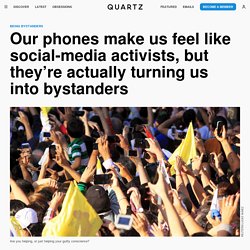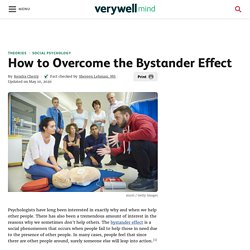

What Is the Bystander Effect? Bystander effect. Bystander effect, the inhibiting influence of the presence of others on a person’s willingness to help someone in need.

Research has shown that, even in an emergency, a bystander is less likely to extend help when he or she is in the real or imagined presence of others than when he or she is alone. Moreover, the number of others is important, such that more bystanders leads to less assistance, although the impact of each additional bystander has a diminishing impact on helping. Investigations of the bystander effect in the 1960s and ’70s sparked a wealth of research on helping behaviour, which has expanded beyond emergency situations to include everyday forms of helping. By illuminating the power of situations to affect individuals’ perceptions, decisions, and behaviour, study of the bystander effect continues to influence the course of social psychological theory and research. Bystander intervention Get exclusive access to content from our 1768 First Edition with your subscription.
The Science of Empathy. Unnamed. The Bystander Effect:The Death of Kitty Genovese. How Could People Watch Alleged Gang Rape 'Like An Exhibit'? Oct. 30, 2009 — -- Members of the Richmond, Calif., community were stunned by the alleged rape and assault of a high school student after a school dance last Saturday.
The Richmond High School Incident – huitinghau77
But a nationwide news audience was even more astonished by allegations that about 20 people in the immediate area observed about 10 men and boys gang rape and beat the 15-year-old girl for two-and-a-half hours on the Richmond High School campus and did not contact authorities.

Psychology experts say the incident, if it occurred as described, may have been the result of escalating wildness facilitated by an isolated, heavily male environment. "If one of the boys or men grabbed her and pulled her toward him ... and somebody else did something else so it became more and more sexual in nature ... we now have a [group of boys] who are pretty wild," said John Darley, a professor of psychology and public affairs at Princeton University.
"Each act licensed what had gone before, and it also made more likely what came next. " 10 Notorious Cases of the Bystander Effect. The bystander effect is the somewhat controversial name given to a social psychological phenomenon in cases where individuals do not offer help in an emergency situation when other people are present.
The probability of help has in the past been thought to be inversely proportional to the number of bystanders. RxUThR8. The bystander effect is being made worse by people filming violent events on their smartphones. On April 9, 2017, a video of a man being dragged off a United Airlines flight was posted on the internet and went viral.

But I don’t need to tell you that. Each of your most outspoken Facebook friends probably posted about the event, highlighting the aspects of it that best reinforced their worldview. The incident was covered all over American media and even sparked outrage in China. The collective focus may have now moved on to its next source of outrage, but there was something that only a few people noticed in the moment: a plane full of quiet passengers. Other than one woman screaming, hardly anyone else on the plane seemed bothered enough by what was happening to raise a ruckus. Instead of intervening in the assault, the passengers stoically took out their cameraphones and pointed them toward David Dao, whose body was dragged along the aisle of the airplane, glasses askew, face bloody, and belly exposed. Bystander Intervention. How to Overcome the Bystander Effect. Psychologists have long been interested in exactly why and when we help other people.

There has also been a tremendous amount of interest in the reasons why we sometimes don't help others. The bystander effect is a social phenomenon that occurs when people fail to help those in need due to the presence of other people. In many cases, people feel that since there are other people around, surely someone else will leap into action.1 While the bystander effect can have a negative impact on prosocial behavior, altruism and heroism, researchers have identified a number of different factors that can help people overcome this tendency and increase the likelihood that they will engage in helping behaviors.2 Some of these include: Witnessing Helping Behavior Sometimes just seeing other people doing something kind or helpful makes us more willing to help others.
Imagine that you are walking into a large department store. Being Observant Being Skilled and Knowledgeable Guilt Feeling Good. Helping Kids Overcome the Bystander Effect. Newscasters love to share stories of kids as young as three years old calling 911 to save a parent’s life.

These stories bear out what research has shown us: Very young children have a propensity to be kind and helpful. Starting as early as 18 months, studies show, toddlers spontaneously help an adult who is unable to pick up something he dropped or finds himself in a similarly tricky situation. Being kind at a cost to themselves makes two year olds happy, and three year olds who cooperate on a task share rewards even when they don’t have to.
But a recent study suggests that, like adults, kids are also subject to a major obstacle to helping: the bystander effect. Active bystander tips.